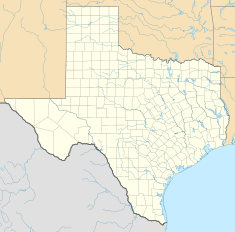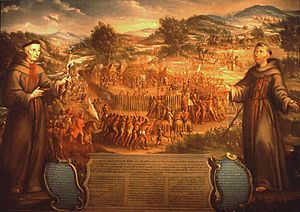Battle of the Twin Villages facts for kids
|
Spanish Fort, Texas
|
|
| Location | Montague County, Texas |
|---|---|
| Nearest city | Nocona, Texas |
| Area | 100 acres (40 ha) |
| Built | 1759 |
| NRHP reference No. | 75002000 |
Quick facts for kids Significant dates |
|
| Significant Event | 1759 |
| Added to NRHP | April 14, 1975 |
| Designated | April 14, 1975 |
The Battle of the Twin Villages was a fight between Spanish soldiers and Native American tribes in 1759. It happened near two villages of the Taovaya tribe, located in what is now Texas and Oklahoma. The Spanish army attacked these villages but were defeated. The Taovaya and other Wichita tribes, along with help from the Comanche, won the battle.
Contents
Why the Battle Happened
Spanish Missions in Texas
In April 1757, the Spanish built a place called the San Saba Mission. It was near where Menard, Texas is today. A military fort, Presidio San Luis de las Amarillas, was also built nearby to protect the mission.
The main goals of the mission were to:
- Teach the Lipan Apache tribe about Christianity.
- Make the Apache peaceful.
- Increase Spain's power in the Great Plains area.
- Stop the French from gaining too much influence with Native American tribes in the north.
Rising Tensions with Native Tribes
The Spanish mission made some Native American tribes in northern Texas very angry. The Spanish called these tribes "Norteños" (meaning "Northerners"). These groups included the traveling Comanche tribe, the village-dwelling Wichita tribes (like the Taovaya, Iscani, and Wichita), and Tonkawa tribes.
On March 16, 1758, a large group of about 2,000 Native American warriors attacked the San Saba Mission. They destroyed it and killed two Franciscan priests and several Christian Native American helpers. The nearby fort had fewer than 100 soldiers, so they could not protect the mission.
Attacks continued near the fort. In December, Comanche warriors killed 21 Apache. In March 1759, they killed 18 more men who were guarding the fort's horses.
Preparing for Revenge
Diego Ortiz Parrilla, the commander of the San Luis Presidio, was an experienced soldier. He decided to lead a mission to punish the Norteños, especially the Wichita tribes.
He slowly gathered a large force:
- Two cannons
- 1,600 horses, mules, and cattle for supplies
- 636 men, including:
- 139 Spanish soldiers
- 241 local fighters (militiamen)
- 134 Apache Native Americans
- 30 Tlaxcalan Native Americans
- 90 Christian Mission Native Americans
- Two priests
Most of the soldiers and Tlaxcalans had muskets and swords. The other Native Americans mostly used bows and arrows. In August 1759, this large, mostly untrained group headed north from San Antonio. Ortiz Parrilla had enough supplies for a four-month trip.
The Native American Tribes Involved
The Wichita People
The Wichita tribes had recently moved south from their original homes in Kansas and northern Oklahoma. They moved because the Osage tribe was expanding into the Great Plains.
In the early 1750s, the Taovaya, the most important Wichita tribe, built two large villages. One was on the north side of the Red River in Jefferson County, Oklahoma. The other was on the south side at Spanish Fort, Texas.
The Wichita traded with the French. Around 1746, they formed an alliance with the Comanche tribe, which helped them become successful. The village at Spanish Fort became a busy trading center. Here, Comanches traded Apache captives, horses, and mules. In return, they got French gunpowder, bullets, knives, and cloth, as well as corn, melons, pumpkins, squash, and tobacco grown by the Taovaya. These Taovaya villages were the main target of the Spanish army.
The Powerful Comanche Tribe
The Comanche were also moving south towards the Spanish settlements in Texas. They were pushing the Apache tribes out of the way. The Comanche were among the first Native Americans in North America to get horses from the Spanish. They used horses to create a nomadic, horse-riding culture, which became typical of the Plains Indians.
The Comanche were a strong and numerous tribe, though they were divided into several independent groups. They were gaining control over a large part of the southern Great Plains with the help of allies like the Wichita.
Other Norteño Tribes
The Tonkawa tribe included several independent groups who spoke similar languages. They lived in central and northern Texas. Other Native American groups who joined in the Norteño raids included the Bidai, Tejas (Hasinai), and Yojuanes. These different tribes, called Norteños by the Spanish, were united because they shared a common enemy, the Apache. They were also worried that a Spanish-Apache alliance would harm their interests.
The Battle Begins
Finding the Villages
The first challenge for the Spanish army was finding the Norteño tribes. On October 2, Ortiz Parrilla found a Yojuane village. It was likely along the Clear Fork of the Brazos River near where Graham, Texas is today. The Spanish attacked this village, killing 49 Yojuanes and capturing 149. Some of the captured Yojuanes agreed to guide Ortiz Parrilla north to a large Taovaya and Iscani village.
The Fortified Village
On October 7, about 60 or 70 Native Americans attacked the Spanish. The Spanish formed a battle line and scattered the small Native American force. They chased them through the woods to the banks of a river, which was definitely the Red River.
The Spanish were surprised to find a fort with a moat and a French flag flying. Inside the fort's wooden walls were the unique beehive-shaped houses of the Wichita. People living outside the walls quickly ran into the fort for safety. Upstream, there were large fields of corn, pumpkins, beans, and watermelons. Downstream, a river crossing was guarded by Native American warriors. The Spanish also saw Comanche tipis scattered around the village.
The Fight
The Spanish estimated they faced up to 6,000 Native Americans, with 500 on horseback. Ortiz Parrilla himself thought there were at least as many Native Americans as his own force of 600. He placed the Tlaxcalans and Mission Native Americans on the right side, the Spanish in the middle, and the Apache on the left. His plan was to attack and storm the fort, using his two cannons for support.
However, Native Americans attacked his army from the sides. They also rushed out of the fort many times to attack the Spanish lines. Each warrior on horseback had two men on foot helping him. Each of these helpers carried two extra loaded muskets. Native American scouts reported that 14 Frenchmen were inside the fort, helping to lead the fighting.
The battle lasted for four hours. The Spanish could not get close to the walled village. Their eleven cannon shots at the wooden walls did not work. The fighting stopped at nightfall, and the Spanish thought about their situation. The Native Americans had captured their two cannons. In the Spanish army, 19 men, mostly Spaniards, were dead, and 14 were wounded. Many men had also run away. The priests and officers asked Ortiz Parrilla to stop fighting.
The next morning, he ordered his army to return to San Saba. The Spanish force and their Yojuane captives reached San Saba on October 25. The Spanish believed they had killed 100 Native Americans in the battle, but this was probably a much higher number than the truth.
What Happened Next
The captured Yojuane people were forced to become servants, and their group soon disappeared from history. The remaining Yojuanes joined the Tonkawa tribe.
After the battle, neither the Spanish nor the Norteño tribes started any major new fights. The Wichita tribes later sought peace with the Spanish and stopped their raids. In 1767, the Spanish gave up on the San Saba mission and their efforts to convert the Apache. The peace between the Spanish and Apache soon ended. Apache and Comanche raiders continued to be a serious threat on the northern edge of Spanish settlements.
It is not completely clear if the battle happened on the Texas or Oklahoma side of the Red River. The remains of the village on the Oklahoma side are now known as the Longest archaeological site.




